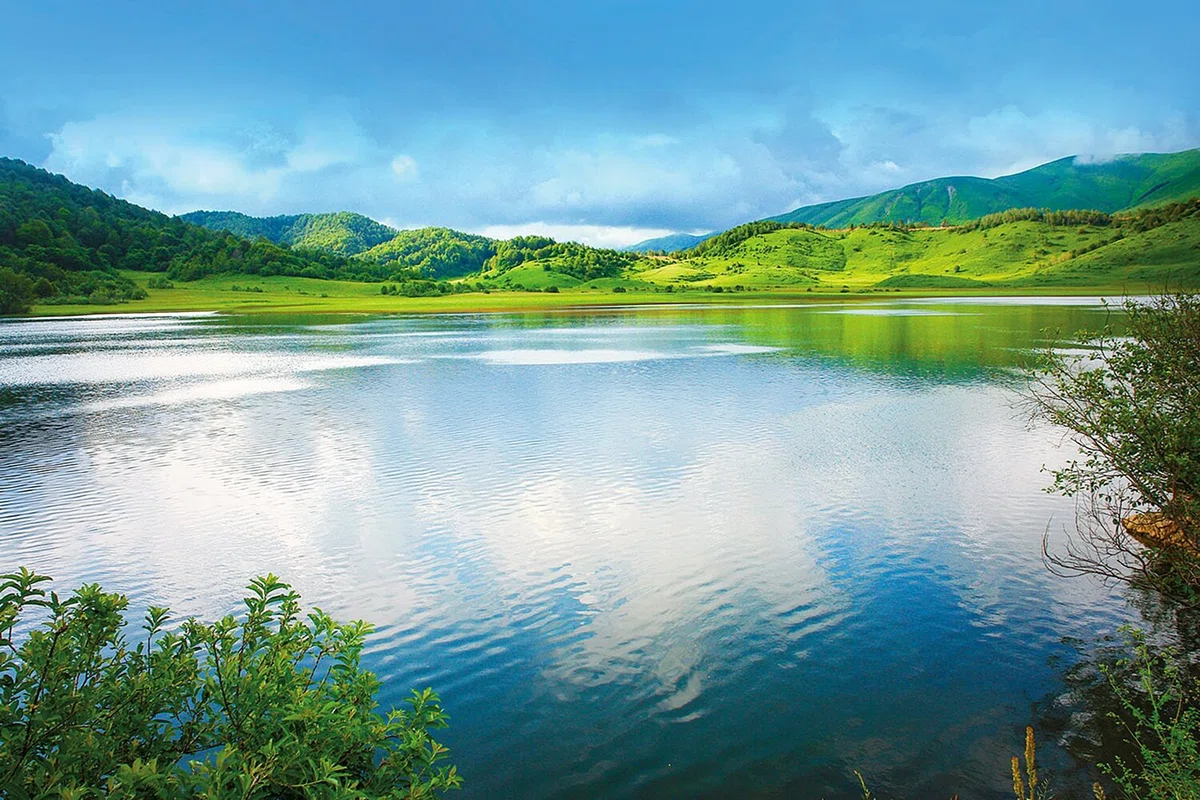
The largest Georgian lakes. Lake Erzo.
Lake Erzo is recognized as the largest karst lake in Georgia. But it is not only karst processes that have contributed to the formation of the lake. Because there are several sinkholes at the bottom of the lake, the water in Erzo often disappears, which is also quite unusual. That is why there are no fish in the lake.
As a result of karst processes (usually chemical decomposition of karst rocks), oval-shaped depressions, which are called karst sinkholes, are formed on the surface of the earth. In some cases, such sinkholes are filled with a lake. For example, Lake Erzo occupies four sinkholes and Lake Davie occupies two. Therefore, Lake Erzo is considered the largest karst lake in Georgia.
Not only the karst processes, but also the shifting of the Earth's crust contributed to the formation of the lake. The mirror surface area of the lake is 0.31 km2 and its water volume 650 cubic meters. There are many karst sinkholes not only on the shore of the lake, but also on its bottom. These holes can be seen even from the nearest mountains (for example, from the highway Tskhinvali - Oni). Funnels 5-19 m deep make the bottom of the lake uneven.
Lake Erzo is covered with ice for almost five months. With a certain periodicity water disappears. According to scientists, the disappearance of water is caused by the presence of karst cavities under the lake bed. There are no fish in the lake.
The Eroscali River (left tributary of the Kvirila River) feeds on the waters of the lake, the bottom of which is criss-crossed with cracks. It flows through the village of Tsona (Java municipality), and by the village of Khapalgomi it connects with the river Ertsostskali. Then it heads westwards towards Imereti. The length of the river is 140 km.
It is noteworthy that the name "Kvirila" (shouting) in Georgian toponymy is associated with water streams flowing in remote places. In 1977, the Liakhvi Reserve was established. This was done to protect the high mountain vegetation found in the valley of the upper reaches of the Patara Liakhvi River and in the southern slopes of the eastern Kavkasioni. The reserve covers 6,388 hectares. Chamois and brown bears are found here. These animals are included in the Red Book of Georgia.

Location:
Java municipality, Tsoni board, the source of the Quirila River, the intersection point of the Racha and Likh ridge, at an altitude of 2300 m above sea level.

Coordinates:
N42028'13''; Е43045'13''.

How to get there:
Not far from Lake Ertso there is a motor road Gori - Tskhinvali - Oni; from Kvemo Ermani you can go to the village Shua Ermani of Java municipality, then the trail leads to the village Zemo Ermani; distance from Tbilisi - 157 km, from Gori - 75 km, from Java - 25 km.













33 comments
Log in to leave a comment
Авторы этой статьи молодцы, потому что они оставили координаты озера Эрцо. Фотография озера очень завораживает и я бы хотела сделать несколько фотографий на таком фоне. Я обязательно посещу это место при возможности.
Я узнала, что озеро Эрцо покрыто льдом более чем на четыре месяца в году. Это вызвано наличием под дном озера карстовых углублений. Я была поражена тем, что в озере не водится рыба. Водами озера питается река Эросцкали и она протекает через несколько сел в Грузии.
Я также узнала, что рядом с озером Эрцо находится Лиахвский заповедник, который был создан для защиты растительности высоких гор и для охраны животных, таких как серны и бурые медведи.
Я бы очень хотела посетить озеро Эрцо и Лиахвский заповедник однажды в будущем. Я думаю, что это будет незабываемый опыт, который я запомню на всю жизнь.
Написано, что карстовые воронки можно увидеть с ближайших гор, хотелось бы посмотреть озера в замороженом состоянии.Думаю выглядит необычно.